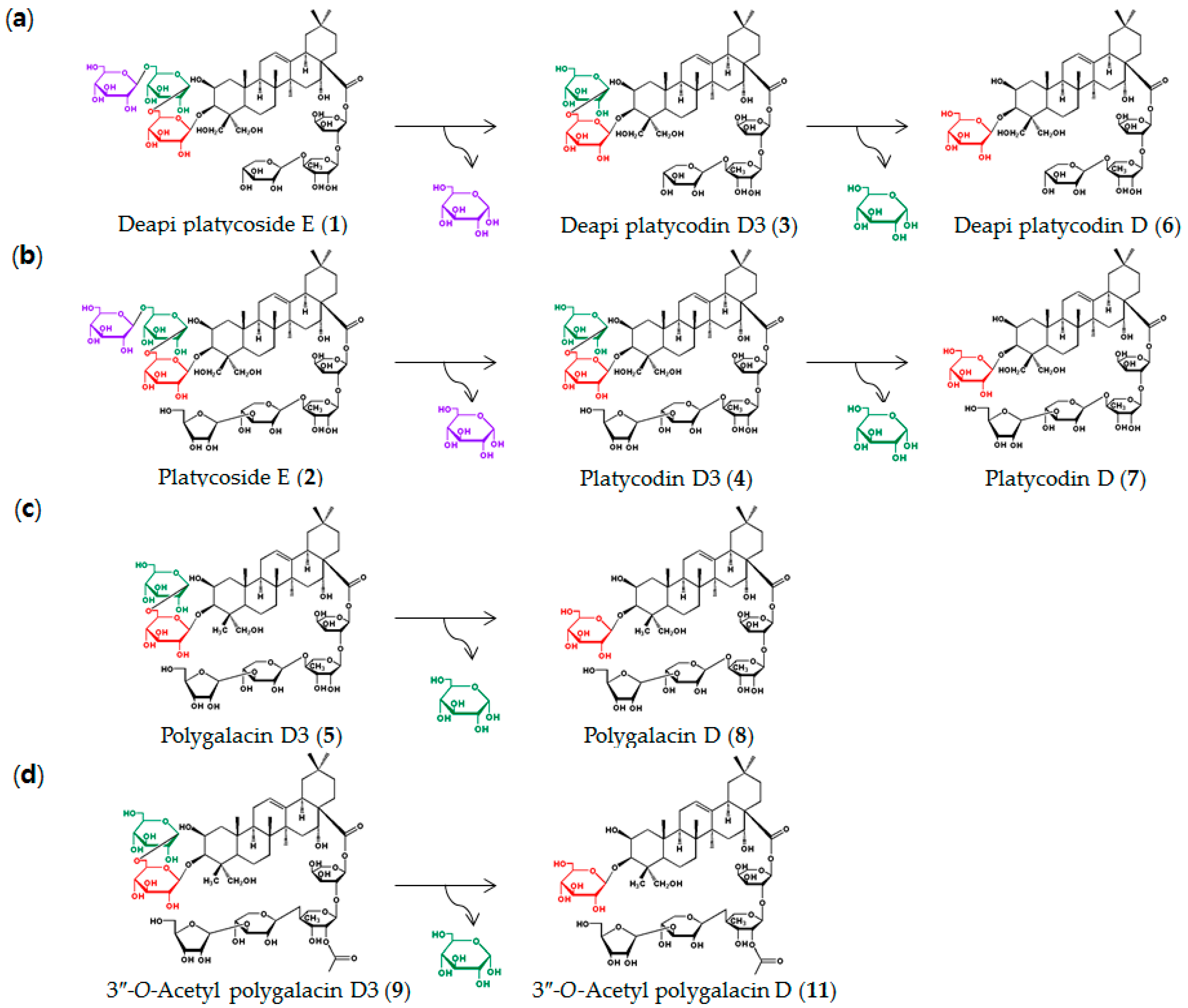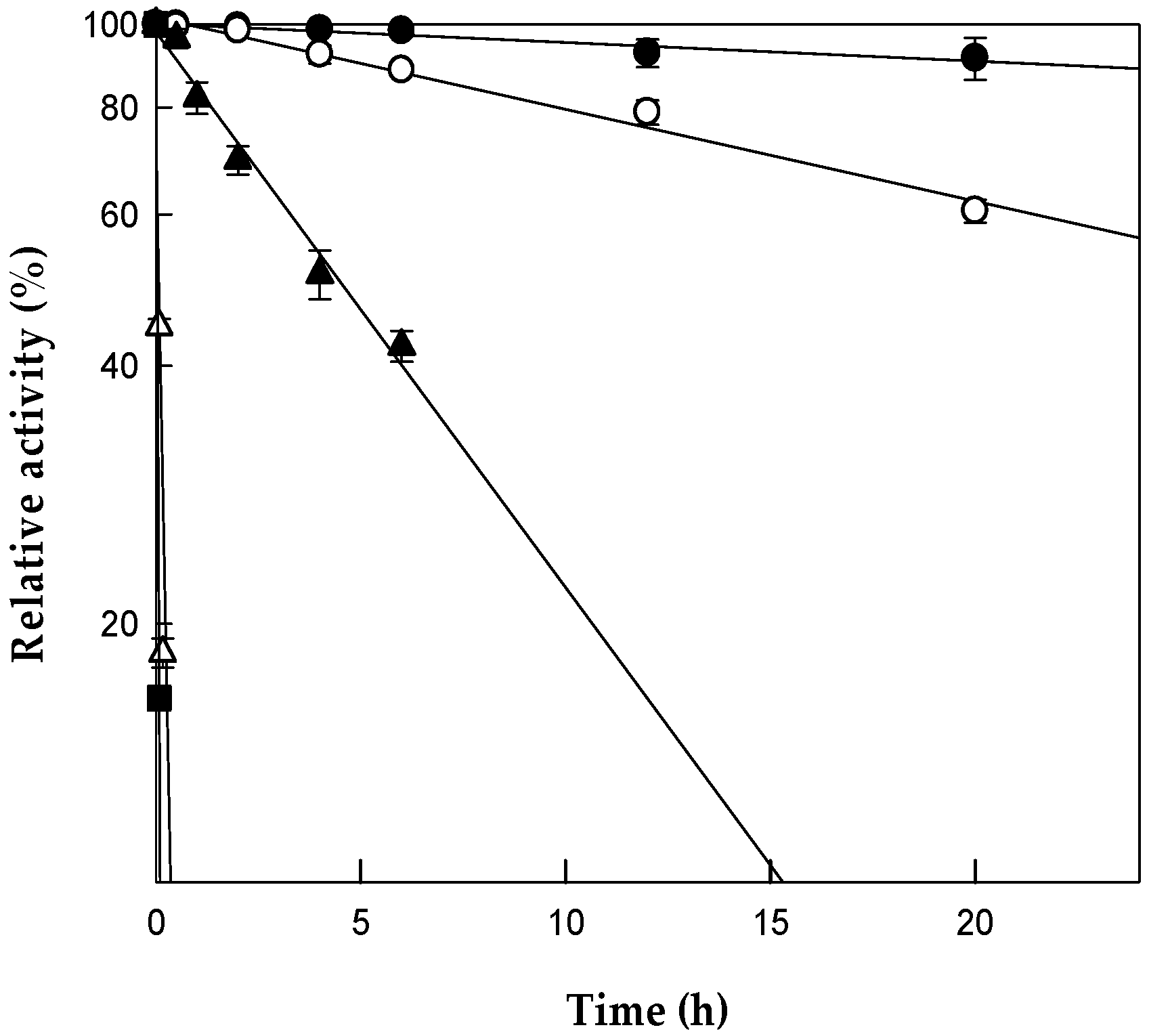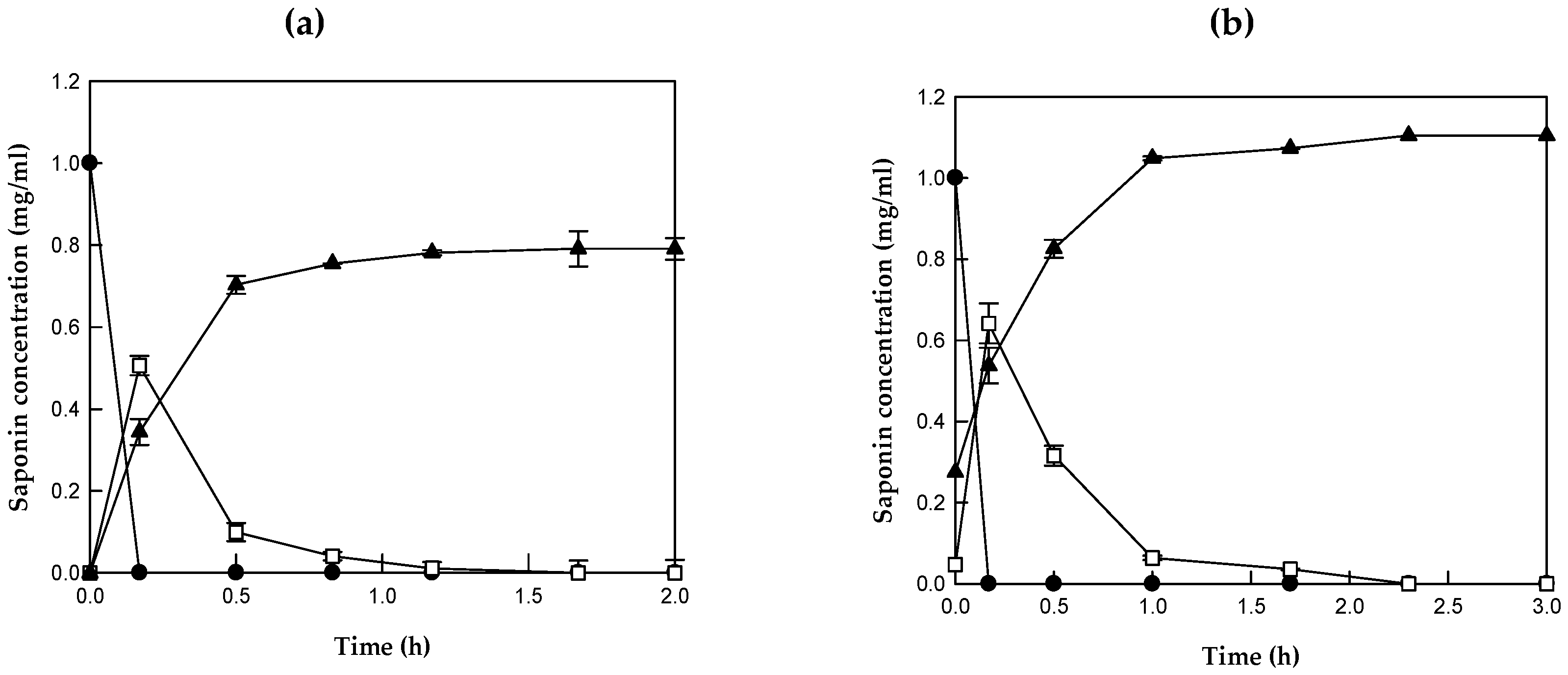Enzymatic Biotransformation of Balloon Flower Root Saponins into Bioactive Platycodin D by Deglucosylation with Caldicellulosiruptor bescii β-Glucosidase
Abstract
:1. Introduction
2. Results and Discussion
2.1. Substrate Specificity of C. bescii β-Glucosidase for Platycosides
2.2. Determination of Biotransformation Pathways of Platycosides in Platycodi Radix Extract Deglucosylated by C. bescii β-Glucosidase
2.3. Optimization of the pH and Temperature for Platycodin D Production by C. bescii β-Glucosidase Substrate Specificity of C. bescii β-Glucosidase for Platycosides
2.4. Optimization of Enzyme Concentration for Platycodin D Production by C. bescii β-Glucosidase
2.5. Biotransformation of Reagent-grade Platycoside E and of Platycosides in Platycodi Radix into Platycodin D by C. bescii β-Glucosidase
2.6. Comparison of Platycodin D Production from Platycosides in Platycodi Radix Extract by C. bescii β-Glucosidase with that by Other Enzymes
3. Materials and Methods
3.1. Plasmid, Bacterial Strains, and Gene Cloning
3.2. Preparation of Platycosides
3.3. Culture Conditions
3.4. Preparation of Platycodi Radix Extract
3.5. Preparation of Enzyme
3.6. β-Glucosidase Activity Assay
3.7. Optimization of Reaction Conditions for Platycodin D Production
3.8. Biotransformation of Reagent-grade Platycoside E and of Platycosides in Platycodi Radix Extract into Platycodin D
3.9. HPLC Analysis of Platycosides
4. Conclusions
Supplementary Materials
Author Contributions
Funding
Conflicts of Interest
Abbreviations
| PE | Platycoside E |
| PD3 | Platycodin D3 |
| PD | Platycodin D |
| Deapi-PE | Deapiosylated platycoside E |
| Deapi-PE | Deapiosylated platycoside E |
| Deapi-PD3 | Deapiosylated platycodin D3 |
| Deapi-PD | Deapiosylated platycodin D |
| Deapi-xyl-PD | Deapiosylated and dexylosylated platycodin D |
| Glc | β-d-Glucopyranose |
| Api | β-d-Apiofuranose |
| Xyl | β-d-Xylopyranose |
| Rha | α-l-Rhamnopyranose |
| Ara | α-l-Arabinopyranose |
| pNP | para-Nitrophenol |
| Ac | Acetyl |
References
- Nascimento, G.G.; Locatelli, J.; Freitas, P.C.; Silva, G.L. Antibacterial activity of plant extracts and phytochemicals on antibiotic-resistant bacteria. Braz. J. Microbiol. 2000, 31, 247–256. [Google Scholar] [CrossRef]
- Kwon, D.Y.; Kim, Y.S.; Hong, S.M.; Park, S. Long-term consumption of saponins derived from Platycodi radix (22 years old) enhances hepatic insulin sensitivity and glucose-stimulated insulin secretion in 90 % pancreatectomized diabetic rats fed a high-fat diet. Br. J. Nutr. 2009, 101, 358–366. [Google Scholar] [CrossRef] [PubMed]
- Zhao, H.L.; Sim, J.S.; Shim, S.H.; Ha, Y.W.; Kang, S.S.; Kim, Y.S. Antiobese and hypolipidemic effects of platycodin saponins in diet-induced obese rats: evidences for lipase inhibition and calorie intake restriction. Int. J. Obes. 2005, 29, 983–990. [Google Scholar] [CrossRef] [Green Version]
- Kim, J.Y.; Hwang, Y.P.; Kim, D.H.; HAN, E.H.; Chung, Y.C.; Roh, S.H.; Jeong, H.G. Inhibitory effect of the saponins derived from roots of Platycodon grandiflorum on carrageenan-induced inflammation. Biosci. Biotechnol. Biochem. 2006, 70, 858–864. [Google Scholar] [CrossRef] [PubMed]
- Halliwell, B. Oxidative stress and neurodegeneration: where are we now? J. Neurochem. 2006, 97, 1634–1658. [Google Scholar] [CrossRef]
- Zhao, H.L.; Harding, S.V.; Marinangeli, C.P.; Kim, Y.S.; Jones, P.J. Hypocholesterolemic and anti-obesity effects of saponins from Platycodon grandiflorum in hamsters fed atherogenic diets. J. Food Sci. 2008, 73, H195–H200. [Google Scholar] [CrossRef] [PubMed]
- Choi, C.Y.; Kim, J.Y.; Kim, Y.S.; Chung, Y.C.; Hahm, K.S.; Jeong, H.G. Augmentation of macrophage functions by an aqueous extract isolated from Platycodon grandiflorum. Cancer Lett. 2001, 166, 17–25. [Google Scholar] [CrossRef]
- Ahn, K.S.; Hahn, B.-S.; Kwack, K.; Lee, E.B.; Kim, Y.S. Platycodin D-induced apoptosis through nuclear factor-κB activation in immortalized keratinocytes. Eur. J. Pharmacol. 2006, 537, 1–11. [Google Scholar] [CrossRef]
- Kang, S.-H.; Kim, T.-H.; Shin, K.-C.; Ko, Y.-J.; Oh, D.-K. Biotransformation of Food-Derived Saponins, Platycosides, into Deglucosylated Saponins Including Deglucosylated Platycodin D and Their Anti-Inflammatory Activities. J. Agric. Food Chem. 2019, 67, 1470–1477. [Google Scholar] [CrossRef]
- Park, C.-S.; Yoo, M.-H.; Noh, K.-H.; Oh, D.-K. Biotransformation of ginsenosides by hydrolyzing the sugar moieties of ginsenosides using microbial glycosidases. Appl. Microbiol. Biotechnol. 2010, 87, 9–19. [Google Scholar] [CrossRef]
- Wie, H.J.; Zhao, H.L.; Chang, J.H.; Kim, Y.S.; Hwang, I.K.; Ji, G.E. Enzymatic modification of saponins from Platycodon grandiflorum with Aspergillus niger. J. Agric. Food Chem. 2007, 55, 8908–8913. [Google Scholar] [CrossRef]
- Ha, I.J.; Ha, Y.W.; Kang, M.; Lee, J.; Park, D.; Kim, Y.S. Enzymatic transformation of platycosides and one-step separation of Platycodin D by high-speed countercurrent chromatography. J. Sep. Sci. 2010, 33, 1916–1922. [Google Scholar] [CrossRef]
- Li, W.; Zhao, L.-C.; Wang, Z.; Zheng, Y.-N.; Liang, J.; Wang, H. Response surface methodology to optimize enzymatic preparation of deapi PD and PD from Platycodi radix. Int. J. Mol. Sci. 2012, 13, 4089–4100. [Google Scholar] [CrossRef]
- Jeong, E.K.; Ha, I.J.; Kim, Y.S.; Na, Y.C. Glycosylated platycosides: I dentification by enzymatic hydrolysis and structural determination by LC–MS/MS. J. Sep. Sci. 2014, 37, 61–68. [Google Scholar] [CrossRef]
- Ahn, H.; You, H.; Park, M.; Johnston, T.; Ku, S.; Ji, G. Biocatalysis of Platycoside E and Platycodin D3 Using Fungal Extracellular β-Glucosidase Responsible for Rapid Platycodin D Production. Int. J. Mol. Sci. 2018, 19, 2671. [Google Scholar] [CrossRef]
- Shin, K.C.; Kim, T.H.; Choi, J.H.; Oh, D.K. Complete Biotransformation of Protopanaxadiol-Type Ginsenosides to 20-O-β-Glucopyranosyl-20(S)-protopanaxadiol Using a Novel and Thermostable β-Glucosidase. J. Agric. Food Chem. 2018, 66, 2822–2829. [Google Scholar] [CrossRef]
- Ha, Y.W.; Na, Y.-C.; Seo, J.-J.; Kim, S.-N.; Linhardt, R.J.; Kim, Y.S. Qualitative and quantitative determination of ten major saponins in Platycodi radix by high performance liquid chromatography with evaporative light scattering detection and mass spectrometry. J. Chromatogr. A 2006, 1135, 27–35. [Google Scholar] [CrossRef]
- Yoo, D.S.; Choi, Y.H.; Cha, M.R.; Lee, B.H.; Kim, S.-J.; Yon, G.H.; Hong, K.S.; Jang, Y.S.; Lee, H.S.; Kim, Y.S. HPLC-ELSD analysis of 18 platycosides from balloon flower roots (Platycodi radix) sourced from various regions in Korea and geographical clustering of the cultivation areas. Food Chem. 2011, 129, 645–651. [Google Scholar] [CrossRef]
- Lee, S.; Yan, Y.; Arasu, M.; Al-Dhabi, N.; Park, S. Seasonal Variation of Saponin Contents in Platycodon grandiflorum. Biosci. Biotechnol. Res. Asia 2016, 13, 119–122. [Google Scholar] [CrossRef]
- Lee, N.K.; Nyakudya, E.; Jeong, Y.S. Bioconversion of Platycodon grandiflorum saponins by the Platycodin D-converting microorganism, yeast Cyberlindnera Fabianii. J. Food Biochem. 2016, 40, 358–365. [Google Scholar] [CrossRef]
- Kim, S.-K.; Kwak, Y.-S.; Kim, S.; Hwang, S.; Ko, Y.; Yoo, C. Improved method for the preparation of crude ginseng saponin. J. Ginseng Res. 1998, 22, 155–160. [Google Scholar]

| No. | Platycoside | Molecular Formula | R1 | R2 | R3 | R4 | R5 |
|---|---|---|---|---|---|---|---|
| 1 | Deapi-platycoside E | C64H104O34 | CH2OH | Glc(1→6)Glc(1→6)Glc | H | H | H |
| 2 | Platycoside E | C69H112O38 | CH2OH | Glc(1→6)Glc(1→6)Glc | Api | H | H |
| 3 | Deapi-platycodin D3 | C58H94O29 | CH2OH | Glc(1→6)Glc | H | H | H |
| 4 | Platycodin D3 | C63H102O33 | CH2OH | Glc(1→6)Glc | Api | H | H |
| 5 | Polygalacin D3 | C63H102O32 | CH3 | Glc(1→6)Glc | Api | H | H |
| 6 | Deapi-platycodin D | C52H84O24 | CH2OH | Glc(1→6)Glc | H | H | H |
| 7 | Platycodin D | C57H92O28 | CH2OH | Glc | Api | H | H |
| 8 | Polygalacin D | C57H92O27 | CH3 | Glc | Api | H | H |
| 9 | 3″-O-acetyl polygalacin D3 | C65H104O33 | CH3 | Glc(1→6)Glc | Api | Ac | H |
| 10 | Platycodin A | C59H94O29 | CH2OH | Glc | Api | Ac | H |
| 11 | 3″-O-acetyl polygalacin D | C59H94O28 | CH3 | Glc | Api | Ac | H |




| Substrate | Product | Specific Activity (μmol/min/mg) |
|---|---|---|
| Deapi-PE | Deapi PD3 | 150.5 |
| PE | PD3 | 68.3 |
| Deapi-PD3 | Deapi-PD | 0.2 |
| PD3 | PD | 0.4 |
| Polygalacin D3 | Polygalacin D | 10.0 |
| Deapi-PD | − | ND |
| PD | − | ND |
| Polygalacin D | − | ND |
| Platyconic acid A | − | ND |
| No. | Platycoside | Before Reaction | After Reaction | ||
|---|---|---|---|---|---|
| Content (%, w/w) | Concentration (mg/mL) | Content (%, w/w) | Concentration (mg/mL) | ||
| 1 | Deapi-platycoside E | 2.65 | 0.07 | ND | ND |
| 2 | Platycoside E | 39.74 | 1.00 | ND | ND |
| 3 | Deapi-platycodin D3 | 0.29 | 0.01 | ND | ND |
| 4 | Platycodin D3 | 1.77 | 0.04 | ND | ND |
| 5 | Polygalacin D3 | 1.97 | 0.05 | ND | ND |
| 6 | Deapi-platycodin D | 0.88 | 0.02 | 3.53 | 0.08 |
| 7 | Platycodin D | 10.60 | 0.27 | 48.36 | 1.10 |
| 8 | Polygalacin D | 29.14 | 0.73 | 34.42 | 0.78 |
| 9 | 3″-O-Acetyl polygalacin D3 | 6.18 | 0.16 | ND | ND |
| 10 | Platycodin A | 6.77 | 0.17 | 7.51 | 0.17 |
| 11 | 3″-O-Acetyl polygalacin D | ND | ND | 6.18 | 0.14 |
| Total | 100 | 2.51 | 100 | 2.27 | |
| Organism or Source | Enzyme | Total Productivity (mg/L/h) | Specific Productivity (mg/g/h) | Concentration (mg/mL) | Molar Yield (%) | Reference |
|---|---|---|---|---|---|---|
| Trichoderma reesei | Cellulase | 0.85 | NR | 0.20 | 100 | [12] |
| Snail digestive tract | Snailase | 673 a | 4.49 a | 14.81 a | 100 a | [13] |
| Cyberlindnera fabianii | Crude enzyme | 2.42 | NR | 0.17 | 43 | [20] |
| Aspergillus usamii | β-Glucosidase | 122 | 40.7 | 0.24 | 99 | [15] |
| Caldicellulosiruptor bescii | β-Glucosidase | 361 | 722 | 1.13 | 100 | This study |
© 2019 by the authors. Licensee MDPI, Basel, Switzerland. This article is an open access article distributed under the terms and conditions of the Creative Commons Attribution (CC BY) license (http://creativecommons.org/licenses/by/4.0/).
Share and Cite
Kil, T.-G.; Kang, S.-H.; Kim, T.-H.; Shin, K.-C.; Oh, D.-K. Enzymatic Biotransformation of Balloon Flower Root Saponins into Bioactive Platycodin D by Deglucosylation with Caldicellulosiruptor bescii β-Glucosidase. Int. J. Mol. Sci. 2019, 20, 3854. https://doi.org/10.3390/ijms20163854
Kil T-G, Kang S-H, Kim T-H, Shin K-C, Oh D-K. Enzymatic Biotransformation of Balloon Flower Root Saponins into Bioactive Platycodin D by Deglucosylation with Caldicellulosiruptor bescii β-Glucosidase. International Journal of Molecular Sciences. 2019; 20(16):3854. https://doi.org/10.3390/ijms20163854
Chicago/Turabian StyleKil, Tae-Geun, Su-Hwan Kang, Tae-Hun Kim, Kyung-Chul Shin, and Deok-Kun Oh. 2019. "Enzymatic Biotransformation of Balloon Flower Root Saponins into Bioactive Platycodin D by Deglucosylation with Caldicellulosiruptor bescii β-Glucosidase" International Journal of Molecular Sciences 20, no. 16: 3854. https://doi.org/10.3390/ijms20163854






